Cloud Seeding Experiment in Idaho
Should state agencies and for-profit companies be given special liability exemptions for experimental projects carried out in an open-air environment? Where there is risk, there must be liability.
🏠“Cloud Seeding Experiment in Idaho” has a New Home
Final Update - Archived: 05/06/25
Thank you so much for your interest in Cloud Seeding!
📌READERS NOTE: "Cloud Seeding Experiment in Idaho" has moved from Big E's Big Mouth Substack to “Read the Study (SA)” Substack. Thank you, SA, for guest posting until you started your own Substack. We're so glad you're part of the Substack family!
("Cloud Seeding Experiment in Idaho" on Big E's Substack will remain in place to preserve previously published links; however, its content was “frozen” on 05/06/25.)

Should state agencies and for-profit companies be given special liability exemptions for experimental projects carried out in an open-air environment?
Where there is risk, there must be liability.
Quick Index has Moved → Click here
Information below was archived on 05/06/25. Please click here for updated “Cloud Seeding Experiment in Idaho.”
Cloud Seeding Experiment in Idaho
Should state agencies and for-profit companies be given special liability exemptions for experimental projects carried out in an open-air environment? HB 266, which passed the Idaho Legislature in 2021, states: “The act of cloud seeding pursuant to a project funded in whole or in part by the state of Idaho or authorized by the state water resource board shall not be the basis of any claim of liability, including but not limited to trespass or public or private nuisance, and shall not require any state or local permits.”
Idaho HB 266, passed in 2021, provides for liability exemptions and no permit requirements for cloud seeding operators hired through the state water resource board (formally, called the Idaho Department of Water Resources or IDWR for short). This law must be amended to remove all liability exemptions and to require permits for cloud seeding operators hired through the state water resource board.
This clause appears to provide liability protection to state agencies like Idaho Department of Water Resources, publicly traded companies like Idaho Power, and private companies like Let It Snow, as well as any other state contracted company.
Would liability protection be expected to promote more rigorous testing and robust safety requirements…or allow potentially risky experimentation?
Interestingly, a 1/30/24 Boise Public Radio article titled “Idaho experiments with new way to boost snowfall in warming world” notes, “Idaho Power has been experimenting with a new material, liquid propane, that can seed clouds...”
Why a Liability Release?
What good is a program that requires liability protections? Where there is risk, there must be liability. Many Idahoans were alarmed with this language and wondered why citizens and private property rights were potentially put in harm’s way for an experimental program.
Cloud seeding is performed by either ground generators or aerial application. Neither method allows Idahoans to opt-out. Citizens began to wonder why cloud seeding operators need liability exemptions.
Risk of accident
According to a 2023 Idaho Aviation accident Score Card (IAASC) report, “Aircraft accidents increased from twenty-four (24) in 2020 to thirty-eight (38) in 2021 – a 35% jump.”
Did Idaho Power, Idaho Water Resources, and cloud seeding stakeholders acknowledge aviation risk and ask for liability exemptions?
Risk of environmental impacts
A 2016 study published by the National Library of Medicine found “cloud seeding may moderately affect biota living in both terrestrial and aquatic ecosystems if cloud seeding is repeatedly applied in a specific area and large amounts of seeding materials accumulate in the environment.” The Department of Environmental Quality (DEQ) must develop and test accumulation levels of all chemical agents used in cloud seeding. This includes silver iodide (AgI) and impacts of liquid propane as well as all trace chemicals.
HB 266 allows cloud seeding operators to experiment without “state or local permits.” No permits and no liability for cloud seeding operators only increased public skepticism in the safety of the program.
Risk of infringement on private property rights
Figure 1 below shows where cloud seeding generators are located and flight maps of aerial cloud seeding. If your property is located near these generators or within flight paths, ask yourself why cloud seeding operations “shall not be the basis of any claim of liability, including but not limited to trespass or public or private nuisance.”
Possible flooding
Idaho Power weather modification application dated 11/1/2021-4/30/2022 outlines termination procedures in place to suspend or stop the program when certain conditions arise. Pages 4-6 state the safeguards Idaho Power will take in the event of potential flooding. By their own admission, there is risk of material damage due to flooding. But is it responsible to place the risk burden on the citizens in case of accidental operator error or unknowingly contributing to environmental damage?
Documents retrieved through a FOIA request confirm the cloud seeding program was terminated in the Wood basin area:
“As of 3/17/23 due to SWE levels in excess of 130% of normal and water supply forecasts greater than 125% of normal. The suspension includes generators and aircraft flight tracks that would target the Wood basin…”
Then two short months later, reports of flooding and evacuations took place in the Wood River Valley:
“Update May 16 at 4 p.m.: The Blaine County Sheriff has issued a mandatory evacuation for eight houses on War Eagle Dr. in Hailey, plus a pre-evacuation notice for residences on seven streets in Hailey's Della View neighborhood, effective Tuesday afternoon at 3 p.m.
According to the National Weather Service, flooding is expected to pick up in the Wood River Valley this week and next.
Overnight temperatures in Hailey this week are forecast to be at least in the upper 40s — about 10 to 15 degrees above normal. Jack Messick with the National Weather Service in Pocatello said that means steady snowmelt.
“All it does is contribute to melt at a fairly fast rate," he said.”
Were temperature shifts considered when earlier season cloud seeding took place? Did cloud seeding operators contribute to runoff flooding?
A recent 2023/2024 NOAA report from Conni Owen states,
“Idaho Power has created a new daily-updated long-term suspension criteria named the Flooding Index.”
It goes on to say,
“Drawbacks to SWSI include [including only two of their four bullets]:
Each streamgage has a different SWSI threshold which makes it harder to interpret at a glance.
Can be difficult to maintain due to database dependencies.”
Did Idaho Power make a new flood index for suspending operations after flooding occurred last season? This brings some additional questions to mind:
Did Idaho Power and Conni Owen (Let it Snow) know last season’s cloud seeding program contributed to flooding and did they revise their termination protocol accordingly?
Was the previous flood index deemed insufficient after previous flooding events?
Is Idaho Power’s switch to a new index working?
Ramping up experimentation
Idaho Power reportedly used ”liquid propane (test generator that will vary dispersal rates for testing purposes)” in their 2021-2022 NOAA application. The public is not provided with information as to how much liquid propane was applied.
In 2023, Idaho Department of Water Resources included in their presentations (provided on a Google Drive link from IDWR) that they sought opportunities to seed with propane. Perhaps a more transparent notification process would include sending public notices or posting public notices before the experiment is rolled out.
Idahoans should be made aware of any experimental “test” Idaho Power or any cloud seeding operator performs.
02/21/2024 UPDATE: A recent public records request reveals that liquid propane is being used at a rate of 10 gallons per hour. Six generators are mapped as an LP (liquid propane) and Agl (silver iodide) site. Methanol is added to the propane to “make a 2 percent solution of propane and methanol.”
Possible chemical damage
The ongoing testing of how silver iodide impacts our environment is a responsible step to assure Idahoans long-term accumulation damage is not taking place.
Where are the protection layers to require the Department of Environmental Quality (DEQ) test and report on seeded basins?
Due to the lack of public access to test reports or the failure to test, this was an important protection measure many Idahoans are seeking.
Kala Golden at Idaho Department of Water Resources (IDWR) stated:
“Idaho’s DEQ measured silver in the seeded basins of Idaho and found silver levels to be below natural background levels of silver in the environment; with no way to even measure it, it was not considered to be of environmental concern, and outside the scope of DEQ. That said, we certainly recognize that over time with the operation of long-term programs, things have the potential to change; because of that, we are looking at repeating our silver sampling efforts in seeded basins over time, to monitor this long term.”
A FOIA request to DEQ found that no such records were found, and no testing procedures are in place. DEQ states:
“I’ve personally connected with all our departments within the agency and none of them have done the testing indicated by Kala Golden.”
The response provided by Kala Golden suggests that DEQ did not actually do any testing, since the likely levels of silver would not be discernible from any background concentrations in surface waters. DEQ stated:
"We don’t have any information regarding this and are not aware of any results that Department of Water Resources believes us to have.”
A reasonable requirement is that DEQ be involved in testing. Additionally, with the new information obtained on liquid propane and methanol use, an independent analysis must take place to carefully assess current and future experimentation.
Usage quantities increased
Older NOAA reports show 7 or 8 grams per hour dispersal of silver iodide. Newer reports show 20 grams per hour. Why the increase?
Some studies indicate over-seeding can decrease moisture. And without required ongoing testing, how will we know what the accumulation levels are?
Chemicals possibly unreported
Earlier NOAA reports show that cloud seeding operations used several chemicals in their application — silver iodide, ammonium iodide, ammonium perchlorate, sodium perchlorate, and acetone (Conni Owen’s 2010 application for Eastern Idaho). However, current reports show only silver iodide. NOAA guidelines state in section 6 of the application to provide the “description of weather modification apparatus, modification agents, and their dispersal rates, the techniques employed, etc.”
Many citizens wonder if all ingredients are being disclosed or only those which “modify” the cloud.
Transparency?
All US weather modification programs must submit a report, interim, and final report to NOAA. According to NOAA’s website, “Submissions will usually be available in the repository within two (2) months after the end of the fiscal quarter.” But we found:
The database is a repository of PDF reports without searchable document fields. Therefore, the reports give limited information.
Reports show a large timespan, usually a 5–6-month window, in which cloud seeding happened.
Interim and final reports only show how many days within the month cloud seeding took place, but do not provide exact dates of seeding.
The public should be notified of these dates and public hearings should be held as other states have modeled. With any open-air experimentation, the public must be made aware of all details of the trial.
Notification requirement
The cloud seeding program is a potential infringement on your private property rights, but you can’t opt-out and are not notified before the spraying takes place. Another reasonable requirement other states dutifully take are public hearings and publishing notice of cloud seeding spraying in a newspaper two consecutive weeks prior to the program start. Idaho currently has no such public notification service.
What’s next? A more responsible model
We submitted a bill modeled along Montana’s better method of notification, permit, licensing, and placing a level of liability on the cloud seeding operator. Each recommendation was reasonable and responsible. Our additions to HB 266 vastly improved the likelihood of public confidence in the cloud seeding program and rightly asked cloud seeding operators to assume some of the liability.
Unfortunately, our bill was not heard during the 2024 legislative session. However, we look forward to working with IDWR, Idaho Power, Let it Snow, and all other stakeholders after the session to improve the cloud seeding program in Idaho.
Please, spread the word and take action.
TAKE ACTION: Call your representative and ask that liability protections be removed for those experimenting with weather modification in Idaho!
Open letter to Idaho citizens and officials 🆕
Introduction
As you may be aware, the Idaho GOP winter meeting committee voted to reject resolution 2025-16 without debate. I spent a considerable amount of time gathering a timeline and references for the resolution presentation and I wanted to share this with you all as IDWR is preparing to ask for more funding this session. I hope you will be informed on all the facts around this questionable program. Most notably, the federal government commissioned a GAO report on cloud seeding and the results were published a couple weeks ago (link below). We have new data that confirms we have no reliable data on the safety or efficacy of cloud seeding. Idaho must realize this program has become state sponsored scientific research.
Resolution: Condemn and Ban Weather Mod & Geoengineering
Responsible stewardship is a crucial topic the GOP must address. Our current state of weather modification experimentation in Idaho has surpassed our understanding of future implications for our beautiful state. The proponents for such initiatives have ramped up potentially risky programs in recent years. This resolution discusses issues around both weather modification and geoengineering, but with many years of data, why is cloud seeding allowed to continue with taxpayer funds and no liability?
According to a presentation by Idaho Power, IPC began investing in cloud seeding in 1993. Starting in 2008, Idaho began the ESPA CAMP program. Growth continued with silver iodide seeding and in 2015 IWRB started cost sharing in the program. 2017 was the SNOWIE project, which provided limited computer modeled evidence, justifying continued seeding. In 2021 HB 266 was passed and a bureaucratic layer was created – shielding IDWR cloud seeding contractors from liability, and allowing little transparency or reporting on behalf of the operators.
More recently, in January 2024, IDWR and IPC announced that in addition to silver iodide, they now experiment with liquid propane to seed at warmer temps.
Finally, in a September 2024 Idaho Water Resource Board meeting, Kala Golden, director of the cloud seeding program for IDWR, discussed allocating funds to obtain more data points to prove cloud seeding efficacy and safety. Reportedly, this data is needed for policymakers to justify the program and expand funding.
Why, after all these years, are we still allowing our tax dollars to go toward funding an unproven, open-air experiment?
Furthermore, the White House published the Congressionally Mandated Research Plan and An Initial Research Governance Framework Related to Solar Radiation Modification in 2023, directing funding of SRM through NOAA. This is yet another scheme to geoengineer the climate with chemicals like sulfur dioxide. Even in small aerosol amounts, the concerns are justified – do we allow Idaho to be ground zero for spraying of silver iodide, liquid propane, sulfur dioxide, methanol, and other pollutants?
Looking outside Idaho, weather modification has been proven to be both ineffective and unpopular. The Israel 4 Cloud Seeding Experiment summary from March 2023 stated, “the results of the Israel 4 experiment are consistent with the hypothesis that seeding has no positive effect at all.” And in North Dakota, in November 2024, voters in Mountrail and Williams counties passed a measure to end weather modification. Federally, the GAO was commissioned to provide a report on cloud seeding. The December 2024 report confirms that cloud seeding effectiveness is unproven.
Let’s join other reasonable states that have banned (or are proposing to ban) weather modification and geoengineering, preserving our beautiful state from large-scale experimentation.
Cloud Seeding References
'Cloud seeding' not effective at producing rain as once thought, new research shows. "In the most comprehensive reassessment of the effects of cloud seeding over the past fifty years, new findings have dispelled the notion that seeding is an effective mechanism for precipitation enhancement." https://www.sciencedaily.com/releases/2010/11/101101125949.htm
Cloud Seeding: The Technology of Fraud and deceit, NJ Law Rutgers. “The purpose of this publication is to expose the fraud, deceit and dangers of uncontrolled and unregulated cloud seeding; to reveal to the public that cloud seeding is not rainmaking and that 90% of all cloud seeding is employed expressly for the purpose of decreasing rainfall. Also, that cloud seeding is the weapon responsible for our serious air pollution problems.” https://njlaw.rutgers.edu/collections/gdoc/hearings/7/76603548/76603548_3.pdf
Flood or Drought: How Do Aerosols Affect Precipitation? "The radiative effects of aerosols on clouds mostly act to suppress precipitation" https://www.researchgate.net/publication/260870731_Flood_or_Drought_How_Do_Aerosols_Affect_Precipitation
Is Cloud Seeding Harmful? "When studying the efficacy and consequences of cloud seeding experiments, the experimenters tend to be biased in saying cloud seeding with silver iodide enhances precipitation without negative consequences. However, much of the literature substantiates that not only does cloud seeding fail to achieve the desired effect, it also yields harmful consequences. Some of these consequences include rain suppression, flooding, tornadoes, and silver iodide toxicity." http://www.ranches.org/cloudseedingharmful.htm
The Israel 4 Cloud Seeding Experiment: Primary Results. “…the results of the Israel 4 experiment are consistent with the hypothesis that seeding has no positive effect at all.” https://journals.ametsoc.org/view/journals/apme/62/3/JAMC-D-22-0077.1.xml
GAO Technology Assessment: Cloud Seeding. “Cloud seeding techniques are similar to those used for some types of climate engineering (or geoengineering), which generally seeks to alter the climate in ways that last longer and are less local.” (page 9)
“…in some studies we reviewed, when uncertainty was considered in estimates of cloud seeding effectiveness, the estimated effect was not distinguishable from zero with a high degree of statistical confidence.” (page 22) https://www.gao.gov/assets/gao-25-107328.pdf
Links
Cited in this Article
Idaho State Government:
Idaho Media: Cloud Seeding Reports
US Federal Government:
🆕 Congressionally Mandated Research Plan and an Initial Research Governance Framework Related to Solar Radiation Modification (White House Report, archived): Read
🆕 United States Government Accountability Office (GAO) Report to Congressional Requesters | December 2024 | TECHNOLOGY ASSESSMENT | Cloud Seeding Technology | Assessing Effectiveness and Other Challenges (PDF, 44 pages, see Summary in the Additional References sections): Read
National Library of Medicine 2016 Report: Potential risk of acute toxicity induced by AgI cloud seeding on soil and freshwater biota: Read
National Oceanic and Atmospheric Administration (NOAA)
Other States:
July 2020 Water Policy Interim Committee (Jason Mohr): Final Report to the 67th Montana Legislature. HJ40 Seeding Clouds: Read
Safety Data Sheets
For more information on liquid propane, methanol, and silver iodide, safety data sheets are included below.
Liquid propane (PDF, Airgas): Read
Methanol (PDF, Fisher Scientific): Read
Silver iodide (Revision 01/03/2025, Sigma-Aldrich): Read
Additional References (alphabetical)

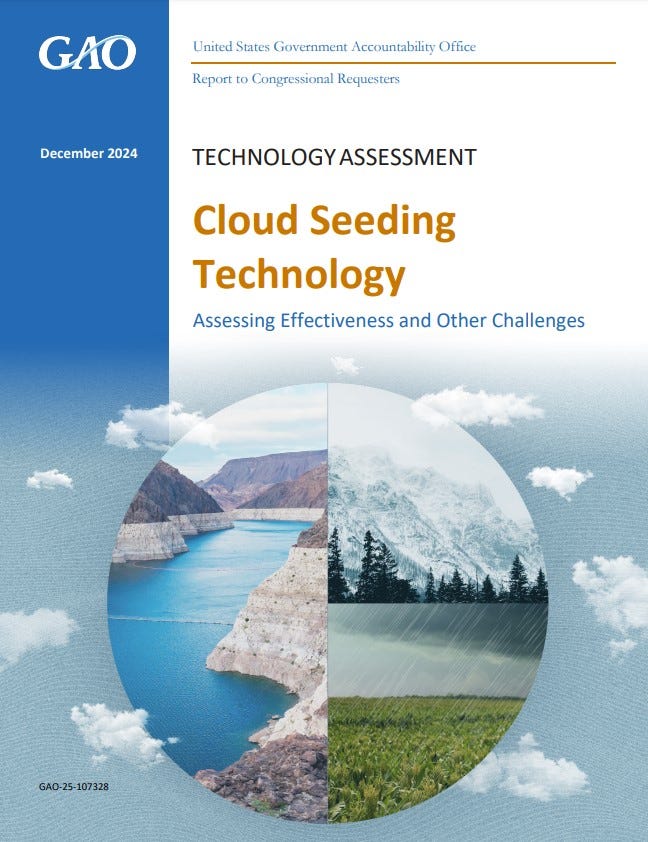
🆕 Americans for a Clean Atmosphere. “Our mission is to inform policymakers and the public about essential legislation to prohibit solar radiation modification (SRM), geoengineering, weather modification, cloud seeding, and other polluting atmospheric experiments or interventions, in order to protect people and nature.” Lists Introduced and Passed legislation in the United States: Read
🆕 Children’s Health Defense: What Is Sprayed in Our Skies? (07/05/24, video 53 min): Watch
🆕 Children’s Health Defense (CHD.TV): Geoengineering Report with Dane Wigington. How geoengineering impacts forests, honeybees, weather, and more. To view Geoengineering Report videos on CHDTV, click here. (Click the ALL tab to view the entire list.)
🆕 Cloud Seeding in Idaho with Kresta Davis on “The Ranch Podcast” (07/27/24, video 35 min). Interview with Kresta Davis, Senior Manager of Water Resources for Idaho Power: Watch
🆕 Cloud Seeding Studies (01/02/25, PDF 1 page with links)
🆕 Congressionally Mandated Research Plan and an Initial Research Governance Framework Related to Solar Radiation Modification (White House Report, archived): Read
🆕 Geoengineering Watch - Geoengineering Affects You, Your Environment, and Your Loved Ones (Dane Wigington): Read
🆕 The Highwire: Search for Geoengineering articles: Search
🆕 How Idaho's Cloud Seeding Transparency Bill (SB1064) Went From a YES to a NO! (03/12/25, video 31:36): Watch
Interview discusses current status of Idaho bills S1064 - Cloud Seeding and S1065 - Weather Modification, how these statuses came to be, and important informed consent and transparency issues surrounding cloud seeding and weather modification. Show notes include resource links and a call to action.
🆕 Idaho Department of Water Resources: Read
🆕 Fiscal Year 2021 Budget Resolution: “Before The Idaho Water Resource Board In The Matter Of Statewide Water Sustainability And Aquifer Stabilization, And The Secondary Aquifer Stabilization, And Secondary Aquifer Planning, Management, And Implementation Fund Fiscal Year 2021 Budget Resolution To Pass Fiscal Year 2021 Budget:” Read
Materials IDWR is using to justify or market their cloud seeding program: Read
🆕 Idaho Water Resource Board (IWRB) Meeting Schedules. You are welcome to attend any regular meeting and provide your feedback directly to the IWRB during their public comment period: Meeting Schedules
🆕 Idaho Department of Water Resources (IDWR) YouTube Channel: Watch
🆕 Idaho Water Resource Board (IWRB) YouTube Channel: Watch
🆕 Video clips from IWRB Finance Committee Meeting No. 8-24 (12/16/24, video 43:27, transcript included) are below. Clips are less than 90 seconds each, both discuss needing more money though they didn’t know how much — just “more”).
Clip 1: (12/16/24, Timestamp 36:42, length 1:20):
Clip 2: (12/16/24, Timestamp 40:32, length 1:28):
Idaho Power: Read
🆕 Idaho Proposed Legislation: No Geoengineering/Weather Modification: Read
🆕 Idaho Republican Party 2025 Winter Meeting — Resolution 2025-16 “Condemn and Ban Weather Modification, Solar Geoengineering, and Any Other Polluting Atmospheric Intervention and Operation Within the Borders of the State of Idaho” (Idaho GOP 2025 Winter Meeting Resolution, pages 51-55): Read
🆕 Legislative Search Results Nationwide (Legiscan) — Shows search results for legislation regarding “weather modification prohibited”: Read
Let It Snow is mentioned in “Opinion: Snow farming season starts” By
Jan Neish Guest (11/24/23). Conni Owen is listed as Let It Snow, Inc. Bookkeeper, Dubois, ID: Read
Liquid Propane (Wikipedia): Read
🆕 Petitions to Oppose Cloud Seeding in Idaho (05/21/24 update)
NOTE: Petition managers often send additional messages, but you can 1) Sign anonymously and 2) Unsubscribe from follow-up messages.Silver Iodide (Wikipedia): Read
SWE (Snow Water Equivalency): Read
🆕 Dr. Kevin Stillwagon: Look, up in the sky!…could it be geoengineering? (07/16/23): One of the best articles about geoengineering, from a long-time airline pilot: Read
Streamgage: Read
SWSI (Surface Water Supply Index): Read
🆕 United States Government Accountability Office (GAO) Report to Congressional Requesters | December 2024 | TECHNOLOGY ASSESSMENT | Cloud Seeding Technology | Assessing Effectiveness and Other Challenges (PDF, 44 pages): Read
Summary
The United States Government Accounting Office (GAO) was commissioned to do a comprehensive study on cloud seeding, releasing the report on 12/19/24. Challenges to the use and development of cloud seeding include:
Lack of Reliable Information: Because we lack reliable information on conducting optimal, effective cloud seeding or its benefits and effects, operations will be less effective and the return on funding investments is unclear.
Optimal Clouds Needed: Cloud seeding operations enhance precipitation only when the right kind of clouds are present, limiting opportunities for success.
Environmental and Public Health Effects Uncertain: A handful of recent studies suggests silver iodide does not pose an environmental or health concern at current levels. However, we do not know how more widespread use of silver iodide could affect public health or the environment.
Potentially Inadequate Reporting: Federal reporting requirements may not include all information necessary to adequately monitor cloud seeding, causing missed opportunities to better evaluate the benefits and potential effects of cloud seeding.
Cloud Seeding vs. Geoengineering: The public may not fully understand the difference between cloud seeding (which has short-term weather affects) and geoengineering (which has longer-term climate effects).
🆕 U.S. Military Sprays Toxic Pesticides in U.S. Residential Areas (07/19/24 - records revealed by ICAN FOIA request): Read
🆕 Zero Geoengineering — One-Stop Geoengineering Information Source
“Geoengineering is planetary-scale environmental engineering of our atmosphere, our weather, the oceans, and the Earth itself”
Many states are taking up the mantle against geo-engineering / weather modification. Zero Geoengineering covers all the developments in detail.
NEXRAD Weather: Deadly Tornados Target Midwest US • Zero Geoengineering (05/27/24 update): Read
State Information Pages Index (all states)
Each state page includes a letter you can send to your representative!Specific State Legislation: Start here (or any page on Zero Geoengineering website), type a state name into the Search box, and press Enter or click the 🔍 icon.
Talking Points 🆕
🆕 Why State Level Geoengineering Legislation is Needed
Rebuttal to declarations (such as this one) that states must defer to the Federal Government to get anything done regarding Geoengineering.
🆕 ACT NOW! Ask Congress to find out "What's Happening in the Skies?"
Send your legislators a letter today!
Write our own letter or use Stand for Health Freedom's form here: https://standforhealthfreedom.com/actions/skies/
More details here: https://tinyurl.com/bdfmkcx2
🆕 Stardust in their Eyes
Stardust is an experimental Stratospheric Aerosol Injection (SAI) company that’s receiving a lot of criticism for their risky experimentation. NOAA introduced Stardust last year:
Stardust, which was established in 2023 as a US start-up with an Israeli R&D center, is composed of 25 scientists and technological leaders from the Israeli academy, national labs and high-tech industry.
Stardust is aiming to contribute to the effort to tackle some of the main scientific challenges and develop the technological building blocks, necessary for a safe and practical deployment of Stratospheric Aerosol Injection (SAI).
Reference: Stardust's approach to developing SAI technological building blocks. By Yanai Yedvab, Stardust CEO (09/26/24)
🆕 Comments and Questions for Idaho’s 2025 Legislators
Idaho’s legislature has had plenty of time to get up to speed on this technology and craft legislation to prohibit experimentation of solar radiation modification and related experimental weather projects, but we close out another year with Idaho failing to properly address these current issues. For example, S1065 - Weather modification will not be heard this session (held in Senate Resources & Environment).
Questions for Idaho Legislators (see full letter to legislators download, below):
Why was S1065 not heard?
Do you believe Idaho should be experimentation grounds for projects like the Make Sunsets project? (See related article.)
Do you believe in global warming (as the NOAA application states) and welcome atmospheric experimentation?
2025-02-18 — GAO Report Letter to Idaho Legislators re: unsubstantiated claims on the cloud seeding (PDF download)
The Truth About Cloud Seeding
(a simple flyer to counteract what we consider to be confusing misinformation from Idaho Power)

GAO REPORT: December 2024 “… in some studies we reviewed, when uncertainty was considered in estimates of cloud seeding effectiveness, the estimated effect was not distinguishable from zero with a high degree of statistical confidence.”
— p.22 GAO Report
INEFFECTIVE: “… the results of the Israel 4 experiment are consistent with the hypothesis that seeding has no positive effect at all.”
— Benjamini, Y., and Coauthors, 2023: The Israel 4 loud Seeding Experiment: Primary Results
UNPOPULAR: Voters decide: Williams and Mountrail Counties are the latest areas to end seeding. Ward and Burke Counties recently ended their operations as well. The organizers said they plan on meeting with state legislators with the intent of passing a bill banning cloud seeding statewide.
— KFYR TV
MODELED DATA: “Although scientists think that cloud seeding and other types of weather modification can increase precipitation in certain circumstances, the effects are difficult to quantify.”
— NCAR

IDAHO POWER CLAIM: “Although the immense amount of data gathered by researchers is still being analyzed, the research clearly shows that cloud seeding enhances precipitation in areas targeted by cloud seeding.”
EXPERT ANALYSIS: “It's a really difficult thing to [directly link increased rainfall to cloud seeding],” says Jeffrey French, assistant professor of atmospheric science at the University of Wyoming in the US. “For the last 60 years, people have tried to link precipitation directly to cloud seeding. And the problem, in a statistical sense, is there is so much natural variability in precipitation; particularly in warmer clouds, like those that they're trying to seed in the UAE, there's a lot of variation that occurs naturally and that we as scientists can't necessarily explain.”
“The problem with the atmosphere is that you can never do a controlled experiment.”
Source: https://wired.me/science/environment/cloud-seeding-uae-dubai-rain-floods/
UN Council Assembly in 2006: Rosalind Peterson talks about weather modification at a UN Council assembly meeting in 2006: https://www.bitchute.com/video/yQSQX3L802vy/
Key points:
Ag/farming implications: Geoengineering is impacting microclimates
Credits: If SRM schemes are offered as a temporary solution until industries clean up their operations, then it will encourage more quick fix credits. We’ll be stuck in a pollute > buy credit (which actually is more polluting) spiral.
Cloud Seeding Q&A 🆕
Below are some brief Q&A handouts you can read and share with others, in PDF format. We’ll add to this section as new questions arise.


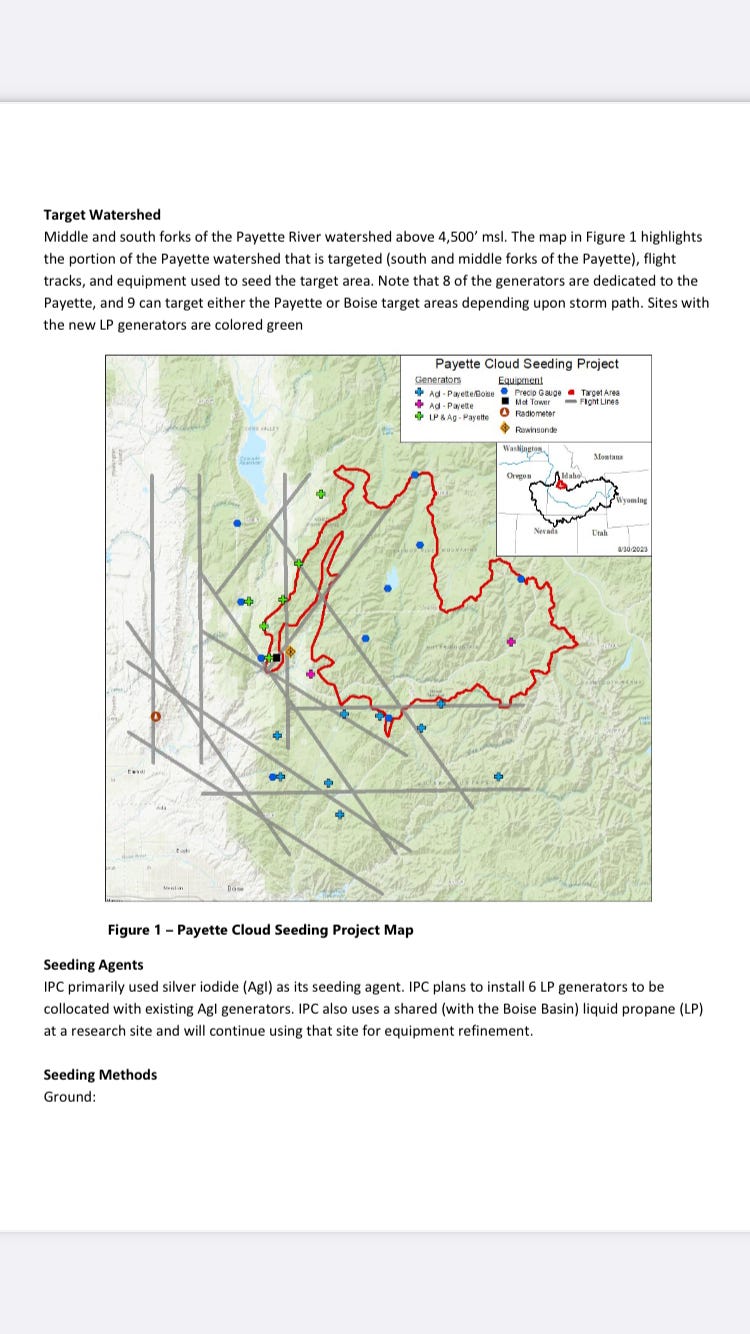
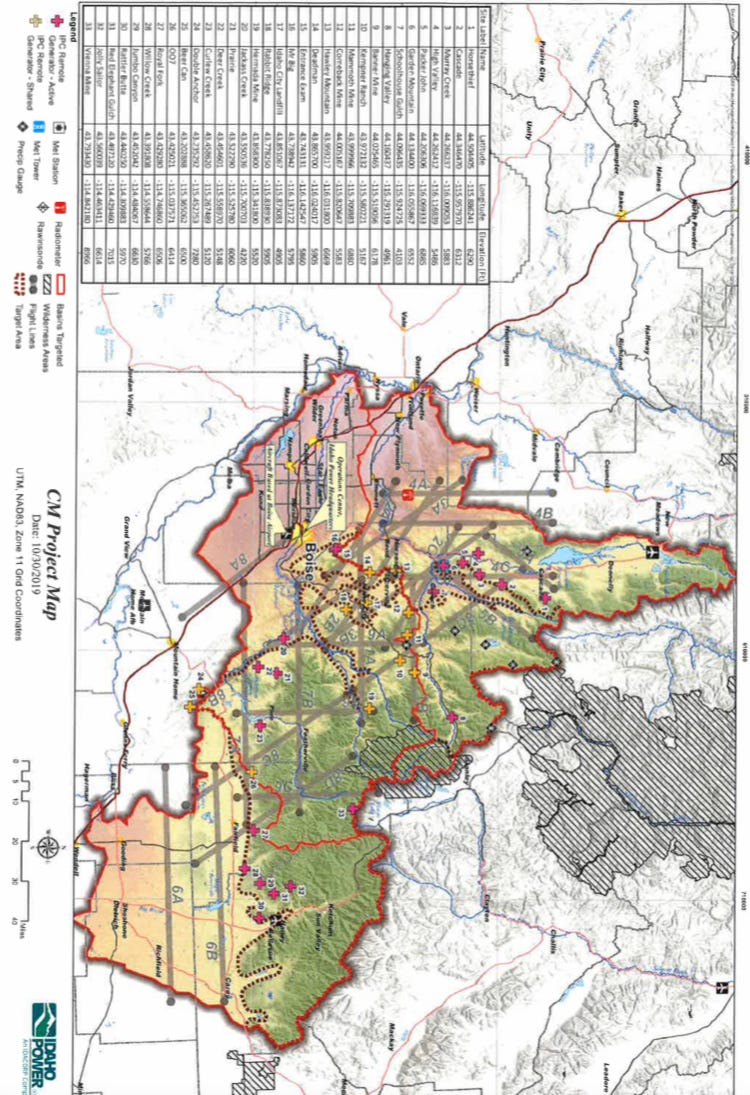
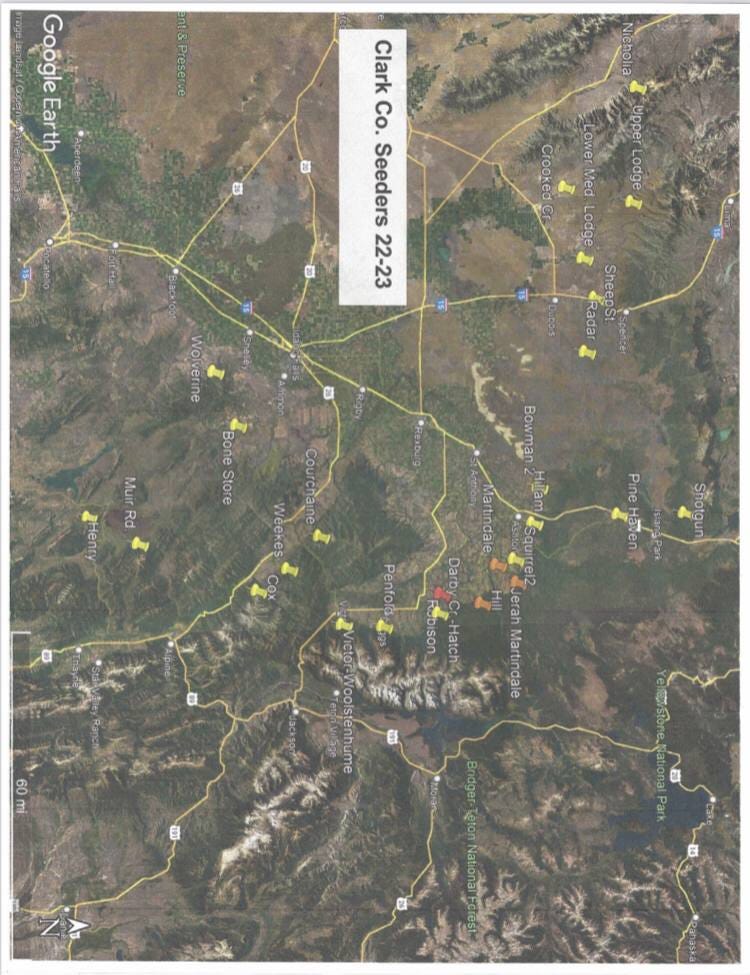
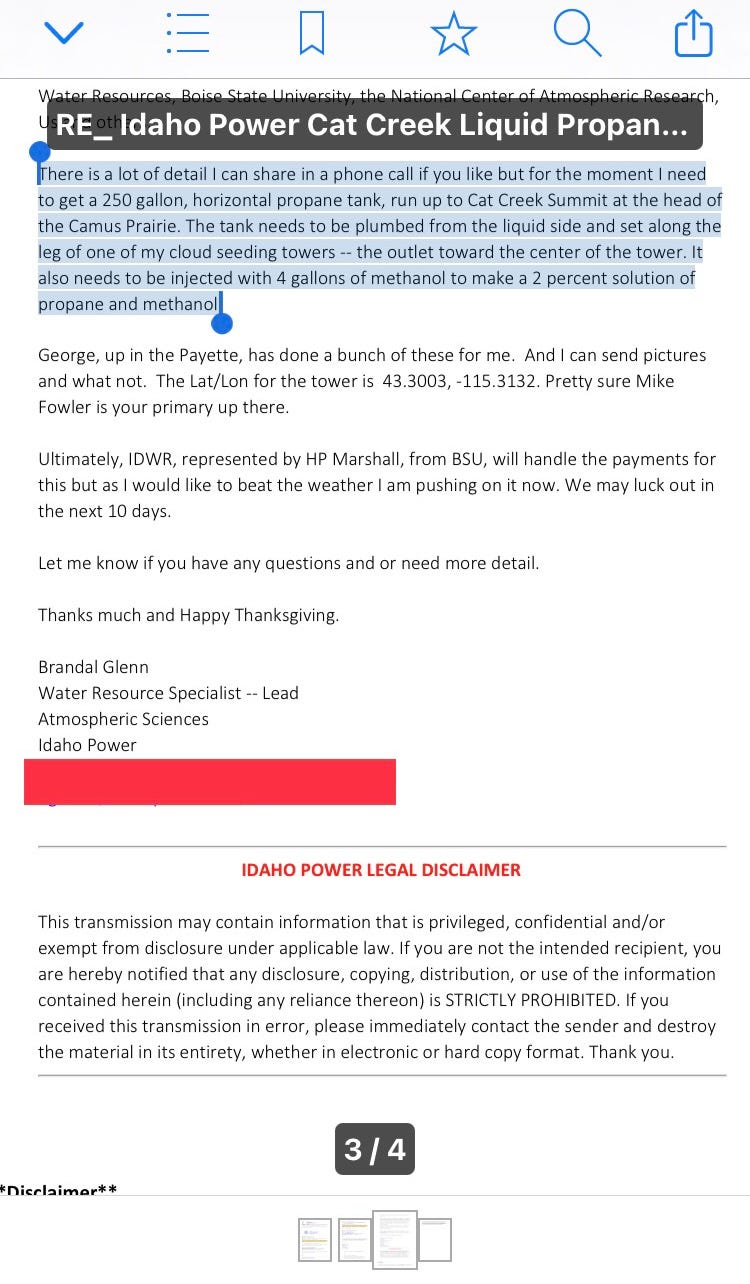

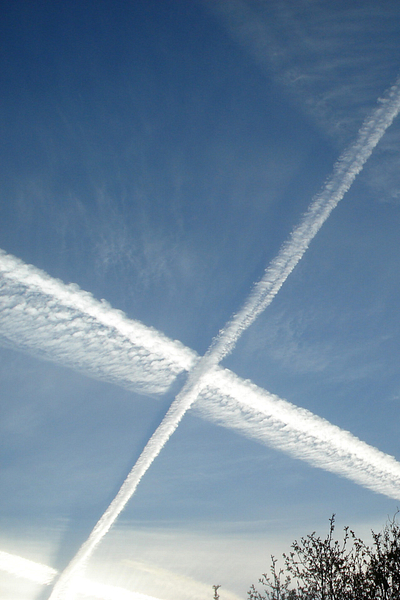


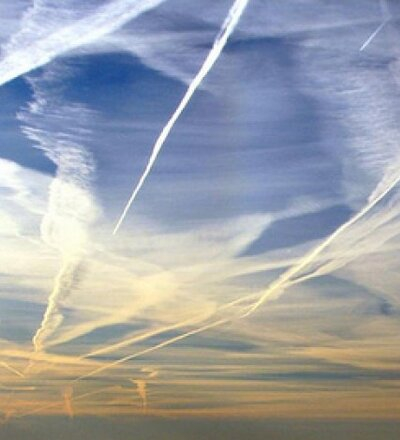

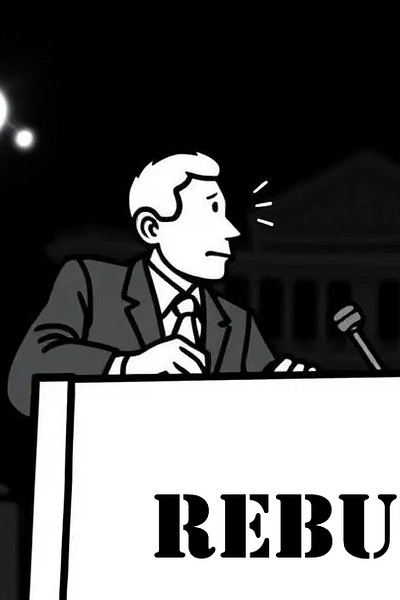




Please help us ban the cloud seeding program in Idaho!
Even if you do not live here you can help us achieve our goal!
Idaho Power uses this program to disperse silver iodide, potassium iodide and now liquid propane into the air via aircraft or ground-based generators places among several basins throughout our state!
There has been no long term research that the chemicals used are not harmful and when looking at silver iodide on its own, it is known as a toxic chemical.
They claim to use so little it is harmless, however if it is used several times a week for half of the year for 20 years straight, there’s no saying the long term affects on our air, water, soil, wildlife, plants, food, livestock and most importantly ourselves and our children.
Silver iodide is especially known to be toxic to aquatic life. So there is also no telling how harmful it is to all of our lakes and rivers and the many different fish we eat from them.
These programs are not helping our state or our planet in the long run. Our neighboring state of Montana does not cloud seed and yet we are both in the same category when it comes to how impacted we are by “climate change”.
Please sign and share!! We need as many signatures as possible!!
The organization change .org asks for donations to promote petitions. We ARE NOT asking for donations to promote this petition! Please just skip this! All we want is signatures! Thank you!
https://chng.it/M6Lx8GFMVf
I know you reported on this.